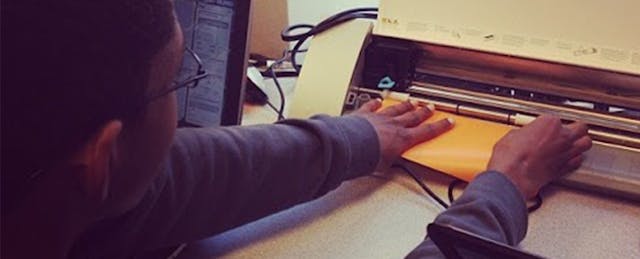Rarely in schools do students have an opportunity to create freely and set all of the constraints of a project, but in the Makerspace at Grand Center Arts Academy (GCAA), a public charter school in St. Louis, MO, self-sufficient creation is the expectation. Curious how to make your own, and draw students in? Here’s our story.
Validating the Hypothesis
The Makerspace at Grand Center Arts Academy opened as a pilot program in the spring semester of 2012 with a budget of $100 and a crew of accommodating custodians who provided a wealth of cardboard. Students in 7th grade were permitted to visit on Fridays during study hall or lunch.
“Although some students worked on coding, Arduino, and 3D design, the core focus was on design thinking, not skill-building. Students used cardboard and other cheap materials to solve everyday problems kids face at school,” said Gregory Hill, co-founder of The Disruption Department who started the Makerspace at GCAA.
Throughout this pilot program, we saw students wanting to define challenges and generate solutions. With this validated hypothesis, in combination with popular support from students, parents, and staff, GCAA expanded the Makerspace in its second year to a larger space with additional hours.
Encouraging Student Agency
Starting in the early 2013-2014 school year, students of all grades were able to drop-in before school, throughout the day, and after school. An average of 70 students a day visited the Makerspace last year, coming in to work on a variety of physical and digital projects. Highlights included an eighth grader who built and programmed a robotic garden that was featured on the MAKE: Blog and two sixth graders who won honorable mention in the ePals Spark! Lab Invent It Challenge.
Now in its third year, student interest in the Makerspace resulted in the formation of three courses that are offered during the school day.
- Design Thinking 101 is a semester-long middle school course where students develop solutions to teacher-designed challenges.
- Make, Hack, Play is a yearlong middle school course where students are empowered to design the challenges and solutions
- STEAM Innovation Lab is a yearlong high school course where students work on design projects that integrate multiple content areas.
Students not enrolled in the courses are still able to drop-in to work on projects during the day, and all three makerspace courses have 20% time embedded for students to work on projects of their choosing.
The Student Response
To really see how this Makerspace has affected the daily life and practices of a student, let’s follow eighth grader Angelo Carrothers.
Angelo visits the Makerspace most days of the week during his study hall--as long as he can show his teacher that he finished his homework.
The first time Angelo ever visited, he completed the required Makerspace Orientation, which included a Makerspace scavenger hunt for items such as tape, rulers, and the materials necessary to power a lightbulb. The goal of the scavenger hunt is for students to start searching through makerspace materials right away, and to understand that is their space--a student space.
Since then, Angelo has made a variety of projects including stop-motion animations, a spinning top, and fixing a broken alarm clock (a wire came unsoldered). In April, Angelo even submitted a pooper-scooper prototype as part of a grant funded by Old Friends Senior Dog Sanctuary in Mount Juliet, TN. But Angelo’s most popular project, by far, is his cardboard skee-ball game. The device exemplifies Angelo’s application of “Design Thinking” and was featured as part of a Makerspace Museum during EdCamp St. Louis.
“He was very proud of himself when he completed it and got to go to the conference. I could tell by his reaction how excited his was. There’s really nothing that he can’t create,” said Angela Carrothers, Angelo’s mom. “He learned not only how to create something from scratch, but also how to tie in the high tech aspects too.”
Angelo’s skee-ball machine started as a piece of inclined cardboard and a marble. Angelo had students in the Makerspace try to roll the marble to see how far it would go. His second iteration included multiple holes for the marble to launch into. Angelo continually tested an improved his design. His iterations included resized 3D printed skeeballs, point values for the holes (cut from vinyl with a Silhouette CAMEO) and a ball return. Users of his game loved playing, but hated taking score, so Angelo taught himself to program a scoreboard using Scratch.
Angelo learned a variety of design skills throughout his skee-ball project: precision cardboard cutting, vinyl cutting, and using Tinkercad for 3D design, but he also learned design thinking - how to test and iterate a project, and grew his creative confidence. None of these skills were explicitly taught, but rather learned by nature of being motivated to finish his chosen project.
Angelo’s experience in the Makerspace is just one of many that validates the power of student-driven projects in a collaborative space. The Makerspace creates a unique atmosphere for students to be active participants in creating their own knowledge. Because students are driven by the product they hope to create, they push themselves to learn whatever skills are necessary to make it a reality.


